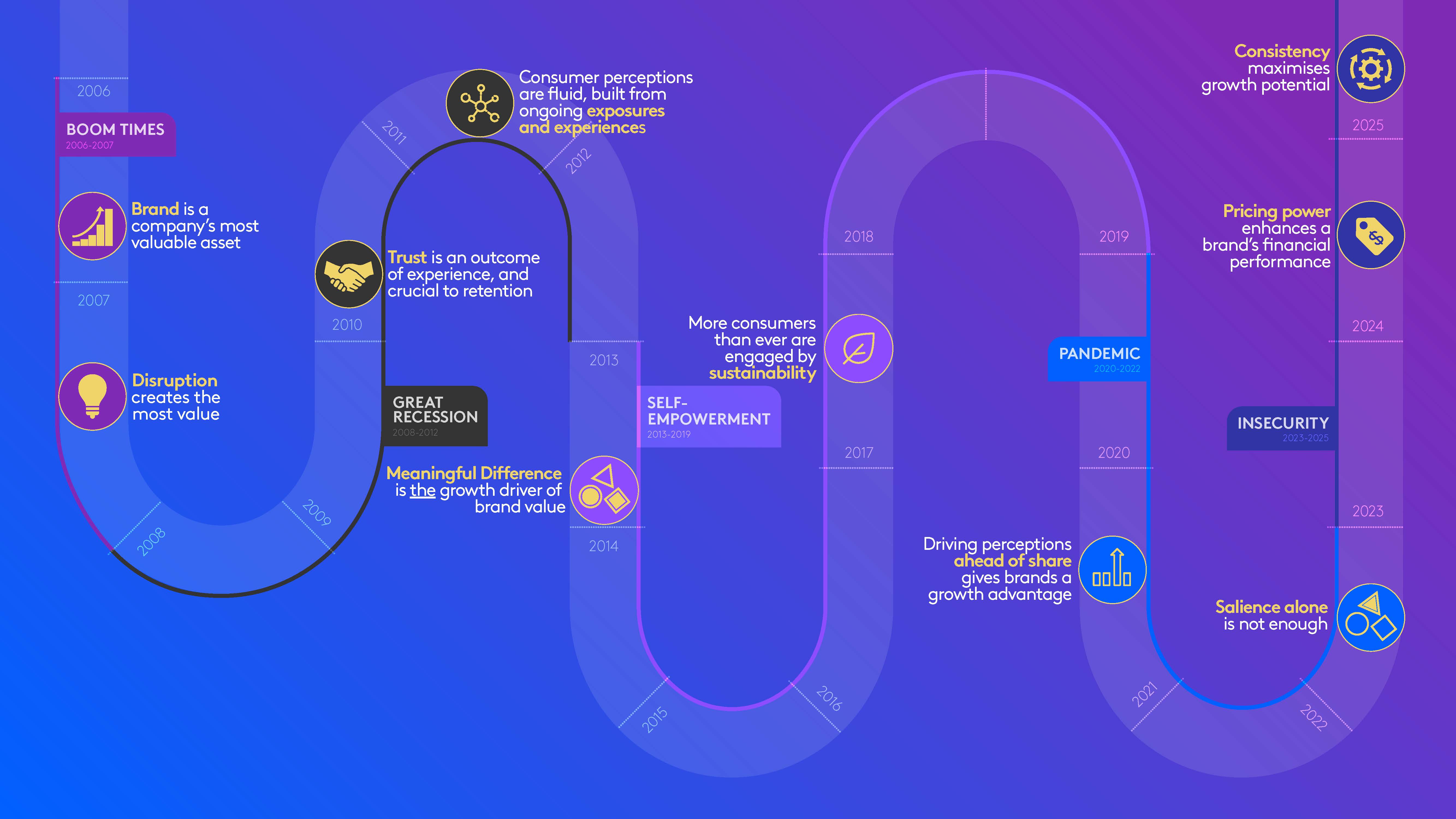For decades, Kantar BrandZ brand equity studies and brand valuations have measured the influences, successes and failures of marketing globally. Now, after reviewing everything we have learned since those first surveys across seven markets in 1998 – and the thousands of brand valuations tracked since 2006 – we have distilled our 10 most important insights.
These insights will help marketers build strong and resilient brands more effectively. They have been stress tested by all the volatility and uncertainty that has characterized the last 20 years. Nearly every strategic landscape has transformed in this time: from media to geopolitics, from the environment to the stock market, change has been the most reliable constant.
Marketers must know how to understand, plan for and overcome volatility. Those that do will write the success stories of the next 20 years. What do they need to prioritize in order to do so?
1. Brand is a company’s most valuable asset
Your brand is a critical asset. So treat it like one and convince all your corporate stakeholders to do the same. This will secure the investments that will make your brand stronger and more resilient. That, in turn, will improve and sustain your long-term returns to the business in the uncertain times to come. Kantar BrandZ provides the evidence that you’ll need to win support for this endeavor and convince your board that marketing is a measurable, mission-critical investment – not a cost to be cut when times are tough.

2. Disruption creates the most value
Brands that disrupted themselves or their category created the majority of incremental value added to the world’s most valuable brands over the last 20 years. The Kantar BrandZ Global Top 100 brand ranking in 2025 is very different to that of 2006. Many brands disappeared completely, as their offer no longer met consumer needs. The likes of Avon and Chevrolet have been displaced by innovators that have redefined what the category can deliver. The most successful have reinvented and stretched themselves well beyond their original product base – like Amazon, Google, Apple, and Microsoft. Innovation is apparent in every category and originates in every part of the world. Fundamentally, innovation done well is about delivering value to business.
3. Trust is an outcome of experience, and crucial to retention
Trust relates to brand demand – which makes it all the more important to deliver on expectations through product quality, customer care and social proof. In its most basic form, the act of branding a product creates an implied contract: a promise to deliver consistently in exchange for the price. It is vital that brand owners ensure this promise is kept and that the customer experience of the brand lives up to this promise on each and every occasion. Further, brands should strive to communicate their promise as widely as possible, so that trust can be created when the experience is great.
4. Consumer perceptions are fluid, built from ongoing exposures and experiences
Consumer decisions about which brand to buy, use, or choose are all influenced by what comes to mind in the moment. In those moments, the brain will nudge consumers toward brands that are recalled most quickly and easily and in a positive light. Often these positive impressions are built and recalled without conscious effort. They are built from a balance of experiences gained, knowledge learned and feelings accumulated in memory. That means marketers need to prioritize the owned, earned and paid touchpoints that offer the greatest balance and influence.
5. Meaningful Difference is the growth driver of brand value
Brands that are Meaningful and Different on Kantar BrandZ metrics have a clear, demonstrated relationship to better business outcomes: increasing penetration, increasing market share, and ultimately increasing brand value for the company. By understanding your brand’s performance on these perceptions and then implementing a strategy based on your brand’s drivers of Meaningful Difference, you can win more effective, efficient returns on your marketing investment.
6. More consumers than ever are engaged by sustainability
Marketers have been subjected to a rollercoaster of opinions around sustainability for the last 20 years. Kantar BrandZ data shows that sustainability is a small, but consistently growing concern for consumers when choosing brands. Going forward, addressing sustainability will help mitigate business risk and could potentially be a platform for any brand. It must be a part of any business’ strategy in the 2020s and the smartest of brands will proactively determine where actions and messages around sustainability can best fit into their own strategic plans.
7. Driving perception ahead of share gives brands a growth advantage
Kantar BrandZ data from 2006 shows that brands with extra equity tend to grow their brand values faster than their peer group. What is ‘extra equity’? It’s the strength of positive brand perceptions among consumers compared to both the size of the brand (its penetration or market share) and to competitors. With the right data, we can compare performance over time for brands with this advantage. And what we see is that ‘extra equity’ not only links to improved long-term brand value growth rates, but also to gains in market share.
8. Salience alone is not enough
You’ve probably heard the term ‘mental availability’. It’s real, but it is much, much more than just brand name awareness and recognition. Effective marketers ensure their brand is not only widely known, but also has ‘deep’ associations. That means attending to the relevance, strength, and balance of the connections consumers make with your brand in their minds, all of which will help ensure that your brand comes to mind quickly and easily. It can be tempting to center your marketing around distinctive assets that substitute flash for meaningfulness. But the wiser play is to invest the majority of your marketing budget in long-term brand building.
9. Pricing Power enhances a brand’s financial performance
Businesses need profit, not just revenue and volume share. Strong equity justifies consumer choice at a price point that protects profits. Investment in brand helps to optimize margins. And, it enables your brand to set the pricing agenda. This is equally true for luxury, premium, mass-market and value-segment brands. Brands in each and all of these segments need to ensure that consumers are positively disposed: that they see your brand as being ‘worth’ the price it charges. Managing price through consumer perceptions brings measurable financial rewards to your brand and business.
10. Consistency maximizes growth potential
It’s no surprise that many of the strongest brands have been around for years, and that consumers know what they stand for. Kantar BrandZ analysis shows a real incremental growth advantage for brands that maintain consistent perceptions across markets. That means that consumers experience the same promise and delivery with each purchase and usage occasion. Consistency is key, until of course, your market is disrupted, so aim for consistency because it is rewarded most of the time. But, also make sure you’re using forward-looking data that can help you to spot (and avoid) an unexpected disruptive challenge.
The 20th anniversary edition of Kantar BrandZ’s Most Valuable Global Brands rankings and report are now available at www.kantar.com/campaigns/brandz/global
For a quick read on a brand’s performance compared to competitors in a specific category, Kantar’s free interactive tool, BrandSnapshot powered by BrandZ, provides intelligence on 14,000 brands. Find out more here.



